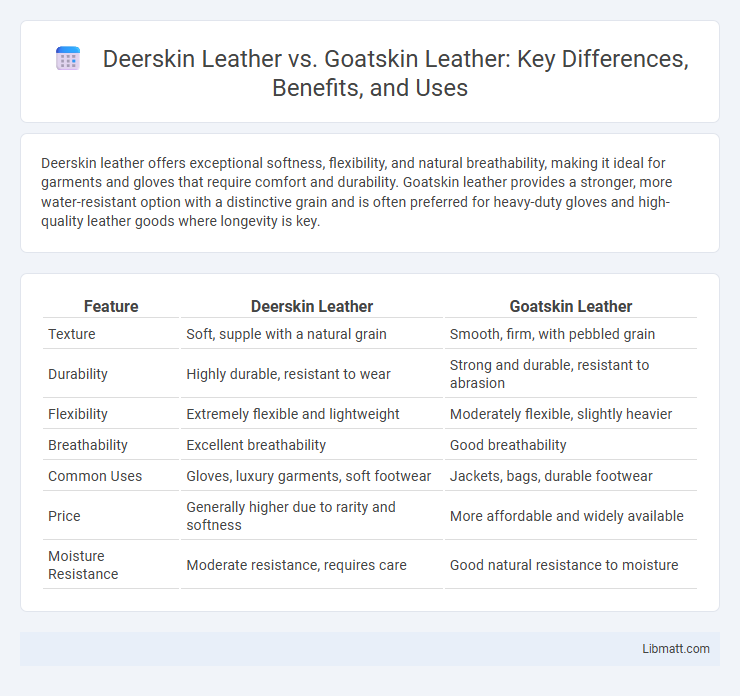Deerskin leather offers exceptional softness, flexibility, and natural breathability, making it ideal for garments and gloves that require comfort and durability. Goatskin leather provides a stronger, more water-resistant option with a distinctive grain and is often preferred for heavy-duty gloves and high-quality leather goods where longevity is key.
Table of Comparison
| Feature | Deerskin Leather | Goatskin Leather |
|---|---|---|
| Texture | Soft, supple with a natural grain | Smooth, firm, with pebbled grain |
| Durability | Highly durable, resistant to wear | Strong and durable, resistant to abrasion |
| Flexibility | Extremely flexible and lightweight | Moderately flexible, slightly heavier |
| Breathability | Excellent breathability | Good breathability |
| Common Uses | Gloves, luxury garments, soft footwear | Jackets, bags, durable footwear |
| Price | Generally higher due to rarity and softness | More affordable and widely available |
| Moisture Resistance | Moderate resistance, requires care | Good natural resistance to moisture |
Overview of Deerskin and Goatskin Leather
Deerskin leather is renowned for its exceptional softness, flexibility, and durability, making it a preferred choice for gloves and high-end apparel due to its natural grain and fine texture. Goatskin leather features a distinctive pebble grain, offering a balance of durability and suppleness ideal for footwear, bags, and bookbinding. Both leathers provide unique characteristics tailored to specific uses, with deerskin excelling in comfort and goatskin prized for its tensile strength and water resistance.
Key Differences in Texture and Feel
Deerskin leather offers a soft, supple texture with a natural grain that feels buttery and pliable, making it ideal for gloves and garments requiring flexibility and comfort. Goatskin leather has a slightly coarser, pebbled grain with a firmer feel, providing greater durability and resistance to abrasion, often preferred for rugged footwear and bags. Your choice between deerskin and goatskin depends on whether you prioritize softness and suppleness or toughness and texture in leather goods.
Durability and Strength Comparison
Deerskin leather exhibits exceptional durability due to its dense fiber structure and natural oils, making it resistant to wear and stretching over time. Goatskin leather offers high strength with a more pronounced grain, providing excellent abrasion resistance and flexibility for heavy use. Both leathers are durable, but deerskin is favored for softness with resilience, while goatskin balances toughness with pliability.
Comfort and Flexibility Factors
Deerskin leather offers superior softness and flexibility due to its fine grain and natural elasticity, making it highly comfortable for prolonged wear. Goatskin leather, while durable and slightly stiffer, provides moderate flexibility and good breathability, contributing to comfort in various conditions. The choice between deerskin and goatskin leathers depends on the desired balance between softness and durability for specific applications.
Water Resistance and Weather Performance
Deerskin leather offers moderate water resistance due to its dense grain structure, making it suitable for light rain and humidity but requiring treatment for prolonged exposure. Goatskin leather excels in weather performance with natural lanolin providing superior water repellency and durability in wet conditions. Your choice depends on the level of exposure; goatskin is preferable for harsher, wetter environments while deerskin performs well under milder, controlled moisture.
Appearance and Aesthetic Appeal
Deerskin leather features a soft, supple texture with a natural grain that often displays subtle, irregular patterns, offering a rustic yet refined aesthetic perfect for luxury leather goods. Goatskin leather is characterized by its pebbled, uniform grain and glossy finish, providing a more structured and polished look favored in high-end fashion accessories. The choice between deerskin's unique, organic appearance and goatskin's consistent, elegant surface depends on the desired style and tactile experience in leather products.
Breathability and Wearability
Deerskin leather offers superior breathability due to its natural porous structure, which allows air to circulate and moisture to escape, keeping your skin comfortable during prolonged wear. Goatskin leather, while slightly less breathable, excels in wearability thanks to its durability and resistance to abrasion, making it ideal for items that require both toughness and flexibility. Choosing between these materials depends on whether you prioritize ventilation and softness (deerskin) or rugged durability and longevity (goatskin).
Common Uses for Deerskin vs Goatskin
Deerskin leather is commonly used for high-quality gloves, jackets, and moccasins due to its softness, durability, and natural breathability, making it ideal for outdoor and fashion apparel. Goatskin leather, known for its strength and flexibility, is often utilized in gloves, bookbinding, and high-end footwear, providing excellent abrasion resistance and a distinct grain pattern. Both leathers serve various specialized purposes, but deerskin is preferred for comfort and supple texture, while goatskin excels in toughness and longevity.
Price Differences and Value
Deerskin leather generally commands a higher price than goatskin leather due to its unique softness, durability, and natural water resistance, making it a premium choice for luxury gloves and high-end fashion items. Goatskin leather offers excellent value with considerable strength, flexibility, and affordability, often preferred for budget-conscious buyers seeking quality without the premium cost. The higher price of deerskin reflects its rarity and superior tactile properties, while goatskin remains a cost-effective option with dependable performance in leather goods.
Which Leather is Best for Your Needs?
Deerskin leather offers exceptional softness, flexibility, and durability, making it ideal for garments and gloves requiring a delicate touch and high abrasion resistance. Goatskin leather is prized for its natural water resistance, toughness, and fine grain, suitable for rugged use in boots, bags, and workwear. Choosing between deerskin and goatskin depends on whether softness and flexibility or durability and water resistance better fit your specific needs.
Deerskin leather vs goatskin leather Infographic

 libmatt.com
libmatt.com